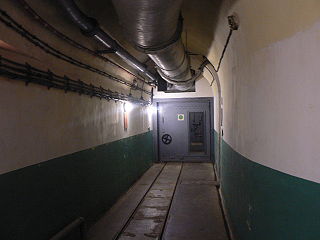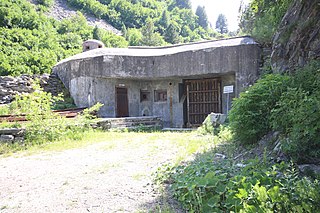
Ouvrage Coucou is a lesser work of the Maginot Line, located in the Fortified Sector of Boulay. The ouvrage consists of two infantry blocks, and is located between the gros ouvrages of Hackenberg and Mont des Welches, facing Germany, just north of Kemplich.

Ouvrage Hobling is a lesser work of the Maginot Line. Located in the Fortified Sector of Boulay, the ouvrage consists of two infantry blocks and two observation blocks, and is located between gros ouvrage Michelsberg and petit ouvrage Bousse, facing Germany. It has been stripped of metals and abandoned.

Ouvrage Saint-Gobain is a work of the Maginot Line's Alpine extension, the Alpine Line. The ouvrage consists of one entry block, one infantry block, one artillery block, one observation block and one combination block. Located in Modane, France, it is just across the valley of the Arc from Ouvrage Saint-Antoine and somewhat to the east of Ouvrage Sapey.

Ouvrage Le Lavoir Is a work of the Maginot Line's Alpine extension, the Alpine Line, also called the Little Maginot Line. The ouvrage consists of two entry blocks, one infantry block, three artillery blocks and one observation block 6 kilometres (3.7 mi) south of Modane, France, guarding the Col de Fréjus. The surface barracks at Le Lavoir were connected to Charmaix by an aerial tram.

Ouvrage Col de Buffere is a lesser work of the Maginot Line's Alpine extension, the Alpine Line. The ouvrage consists of one combat block at an altitude of 2,393 metres (7,851 ft) on the Col de la Buffère. Additional blocks were planned but not built or were left incomplete.

Ouvrage Col du Granon is a lesser work of the Maginot Line's Alpine extension, the Alpine Line. The ouvrage consists of one entry block, one infantry block and one observation block covering the Col du Granon as part of the defenses of Briançon and Grenoble. The ouvrage lies at an altitude of 2,329 metres (7,641 ft).

Ouvrage Les Aittes is a lesser work of the Maginot Line's Alpine extension, the Alpine Line. The ouvrage consists of one entry block, three infantry blocks and one observation block, about two kilometers east of Cervières, Hautes-Alpes at an altitude of 2,029 metres (6,657 ft)..

Ouvrage Saint Ours Haut is a work of the Maginot Line's Alpine extension, the Alpine Line, also known as the Little Maginot Line. The ouvrage consists of one infantry block, one artillery block, two observation blocks and one combination block in the vicinity of the Col de Larche. It is located on the territory of the commune of Meyronnes. Construction began in March 1931, at a cost of 15.1 million francs.

Ouvrage Plate Lombard is a lesser work of the Maginot Line's Alpine extension, the Alpine Line. The ouvrage consists of one entry block, two infantry blocks and one observation block. Unusually for an ouvrage, Plate-Lombard was built by MOM, which usually was responsible for lesser fortifications. The isolated position was commanded in 1940 by Lieutenant de Loye. It controlled the Fouillouse valley and the Col du Vallonet.
Ouvrage Saint Ours Nord-est is a lesser work of the Maginot Line's Alpine extension, the Alpine Line. The ouvrage consists of two infantry blocks. The associated underground support galleries are arranged with a short gallery connecting Blocks 1 and 2, with parallel stubs at Block 2. While it is listed in some sources as an ouvrage owing to its construction by CORF, it is more like an infantry abri or shelter.

Ouvrage Restefond is a work of the Maginot Line's Alpine extension, the Alpine Line. The ouvrage consists of one artillery block and three observation blocks at the summit of the Col de la Bonette. The entry block and an artillery block were not completed, and a further block was never built. At 2,733 metres (8,967 ft), Restefond is the highest Maginot ouvrage.

Ouvrage Col de Restefond is a lesser work of the Maginot Line's Alpine extension, the Alpine Line. The ouvrage consists of three infantry blocks. It is located directly adjacent to the Col de Restefond road at an altitude of 2,680 metres (8,790 ft). Construction work was completed in 1934, but the ouvrage was not armed until 1938.

Ouvrage La Moutière is a lesser work of the Maginot Line's Alpine extension, the Alpine Line at an altitude of 2440 meters. The ouvrage consists of one entry block, one infantry block and one observation block, with an unarmed exit block. The ouvrage supported the Ouvrage Restefond on the crest of the pass, guarding its southern flank. It also covered the Col de la Barcelonnette to the north. The position was built between 1931 and 1935.

Ouvrage Valdeblore is a lesser work of the Maginot Line's Alpine extension, the Alpine Line. The ouvrage consists of one entry block, one infantry artillery block and one observation block at an altitude of 842 metres (2,762 ft). Valdeblore was built starting in November 1930 by Poiljeux contractors, and was completed by Thorrand et Cie in April 1933 at a cost of 1.6 million francs.

Ouvrage La Séréna is a lesser work of the Maginot Line's Alpine extension, the Alpine Line. The ouvrage consists of one entry block at an altitude of 1,292 metres (4,239 ft). Two more blocks were planned but not completed before the invasion of France in 1940.

Ouvrage Col du Caire Gros is a lesser work of the Maginot Line's Alpine extension, the Alpine Line. The ouvrage consists of two entry blocks at an altitude of 2,048 metres (6,719 ft). Additional blocks were planned but not built.

Ouvrage Flaut is a work of the Maginot Line's Alpine extension, the Alpine Line, also called the Little Maginot Line. The ouvrage consists of one entry block, one infantry block and one artillery block at an altitude of 771 metres (2,530 ft). The position was intended, acting with Ouvrage Gordolon, to stop an approach by Italian forces from the north towards Nice through the Vésibie Valley.

Ouvrage Monte Grosso is a work of the Maginot Line's Alpine extension, the Alpine Line, also known as the Little Maginot Line. The ouvrage consists of one entry block, four artillery blocks and two observation blocks facing Italy. It was the largest ouvrage in the Alps It is part of the fortifications surrounding Sospel, which protect the approaches to Nice from the north.

Ouvrage Champ de Tir, also known as Champ de Tir de l'Agaisen is a lesser work of the Maginot Line's Alpine extension, the Alpine Line. It is located at an altitude of 672 metres (2,205 ft), less than 1 kilometer to the northwest of Ouvrage l'Agaisen. The ouvrage consists of two entry blocks and one infantry block, sited to control the valley of the Nieya and to observe for l'Agaisen.

Ouvrage Col des Banquettes is a lesser work of the Maginot Line's Alpine extension, the Alpine Line, also called the "Little Maginot Line". The ouvrage consists of two entry blocks and one infantry block facing Italy at the top of the Col des Banquettes, 2 km northwest of Saint-Agnès. The position controlled the pass of the same name and was covered by Ouvrage Sainte-Agnès and the positions at Pic-de-Garuche.











